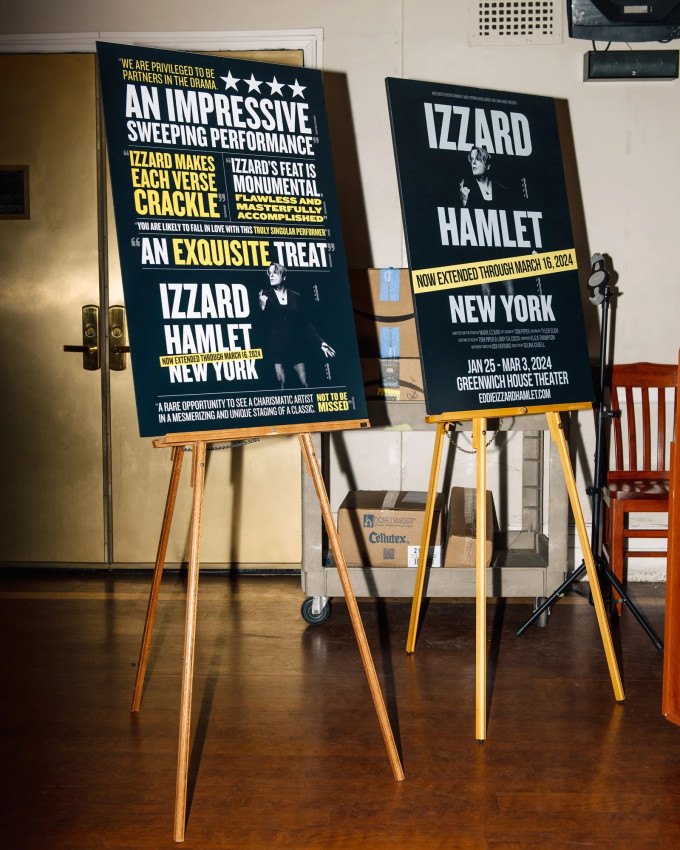There’s a bright spot in New York Theater. It’s not where you think
Written by Michael Paulson

Broadway is struggling through a postpandemic funk, squeezed between higher production costs and lower audience numbers just as a bevy of new shows set sail into those fierce headwinds. At the same time, New York’s off-Broadway nonprofits, long essential seedbeds for many of the nation’s most acclaimed playwrights, are shedding staff, programming and even real estate.
But there is an unexpected bright spot this season. Commercial off-Broadway, a small sector of New York’s theatrical economy and one that has for years been somewhere between difficult and dormant, is back in business.
“Oh, Mary!” a madcap comedy that imagines Mary Todd Lincoln as a daffy alcoholic, is selling out nightly at a 295-seat theater in the West Village, and is likely to transfer to Broadway this summer. Eddie Izzard’s solo “Hamlet” did well enough at a 199-seat theater in Greenwich Village that it relocated to a 349-seat house in the East Village, and next is planning runs in Chicago and London.
A commercial revival of “Danny and the Deep Blue Sea,” an early John Patrick Shanley play about two misfits who meet at a Bronx bar, had a profitable run downtown this season thanks to its two stars, Aubrey Plaza and Christopher Abbott. A new play, “Job,” featuring two “Succession” alums, rode word-of-mouth to profitability, and is also exploring a Broadway transfer.
And a pair of good-time musicals, “Little Shop of Horrors” and “Titanique,” have settled in for open-ended off-Broadway runs.
“It’s interesting, because up to the pandemic, I think people had written off commercial off-Broadway entirely,” said George Forbes, executive director of the Lucille Lortel Theater, which develops, presents and champions off-Broadway work. “The narrative was that it wasn’t financially viable. Commercial theaters were disappearing, and the not-for-profits were building new spaces.”
Now the tables have turned, although with plenty of caveats. Real estate is a limiting factor; there aren’t that many rentable off-Broadway venues with sufficient seating capacity for profit-minded producers. One long-running commercial off-Broadway hit, “Stomp,” closed last year after a 29-year run, and another, the immersive “Sleep No More,” is planning to close next month. And a number of factors could drive up costs: IATSE, the union representing stagehands, has been organizing off-Broadway crews, and Actors’ Equity Association, representing performers and stage managers, will begin negotiations later this year on a new off-Broadway contract.
The commercial off-Broadway boomlet seems to have been spurred by the success of “Little Shop,” a revival of the classic camp horror musical, which opened at the Westside Theater in 2019 and, with a long interruption caused by the pandemic, has been running since.
Producers and investors are finding themselves drawn to off-Broadway for several reasons. The primary one is economic: Production costs on Broadway have skyrocketed since the pandemic, making it significantly harder for shows to achieve profitability there, and causing producers and investors to look for lower-cost alternatives. (Many are also turning to Britain, where production costs are lower.)
How big are the cost differences? “Oh, Mary!” which has five actors, period costumes and several set changes, cost $1.2 million to capitalize off-Broadway. By comparison, “The Shark Is Broken,” a three-character comedic look at the making of “Jaws” that was set entirely within a small fishing vessel, cost $5.15 million to capitalize earlier this season on Broadway.
The challenge is that the potential upside of off-Broadway is also lower, because the theaters are smaller.
The dire straits confronting the nonprofit theater sector also contribute to the interest in commercial off-Broadway.
 Posters for ÒHamlet,Ó starring Eddie Izzard, in the lobby of the Greenwich House Theater in the West Village, in New York, March 1, 2024. Commercial off-Broadway, a long-dormant sector of New York CityÕs theater economy, is having a banner season, but can it last? (Clark Hodgin/The New York Times)
Posters for ÒHamlet,Ó starring Eddie Izzard, in the lobby of the Greenwich House Theater in the West Village, in New York, March 1, 2024. Commercial off-Broadway, a long-dormant sector of New York CityÕs theater economy, is having a banner season, but can it last? (Clark Hodgin/The New York Times)
“As the nonprofits have had to produce far less, instead of waiting to be produced, theater artists are taking careers into their own hands and doing it their way,” said Leigh Honigman, one of the producers of “You Don’t Have to Do Anything,” a small play that ran off-Broadway earlier this year.
Because multiple nonprofit theaters are now saddled with underused theaters, the boundaries are blurring. Money from commercial producers is often used to finance shows at nonprofit theaters, and nonprofit theaters are increasingly renting their spaces to commercial producers. The Lucille Lortel Theater, for example, is run by a nonprofit foundation, and until the pandemic rented only to nonprofit productions. Then it decided to rent to commercial productions as well, and now that is where “Oh, Mary!” is running.
When actress Annaleigh Ashford reached out to producer Aaron Glick for help breathing more life into “The White Chip,” a play about alcoholism recovery that stars Joe Tapper, her husband, they quickly found a home for their commercial production at MCC, a nonprofit theater. “We didn’t want to wait for a nonprofit season — we wanted to carve our own path,” Glick said.
The potential growth of commercial off-Broadway is limited by a shortage of available downtown theaters with several hundred seats. Over time, theaters have been lost to redevelopment, and in recent years the Minetta Lane was taken over by Audible (which has become a very active commercial off-Broadway producer at the theater) and the Cherry Lane was bought by the indie film studio A24 (which has yet to resume programming at the building).
“It’s pretty clear that commercial off-Broadway is back and viable — it’s just hit after hit that we’re seeing — but the problem is that there are no spaces,” said Oliver Roth, who last year produced an impossible-to-get-into adaptation of “Uncle Vanya” (staged at first in a 40-seat loft and then in a 95-seat space) that turned a profit. “I would have run that forever if there wasn’t a mattress company coming in for New York Fashion Week to use the event space we were in.”
This article originally appeared in The New York Times.
Disclaimer: The copyright of this article belongs to the original author. Reposting this article is solely for the purpose of information dissemination and does not constitute any investment advice. If there is any infringement, please contact us immediately. We will make corrections or deletions as necessary. Thank you.





